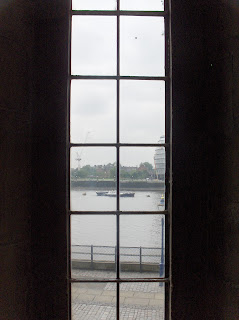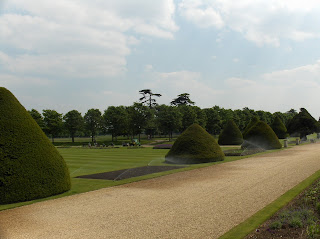The Tower of London is perhaps one of the most well-known remnants of the Norman Conquest. It was William the Conqueror who added the White Tower (which is actually a keep) within the grounds around 1078 AD. Originally built as a lavish palace in its early days, it was predominately used as a royal residence. Though it was used as a prison even in it's early days, it didn't become renowned for it until roughly 16th century, where it was used rather frequently and has held many a royal prisoner, such as Queen Elizabeth I (though she was a princess at the time.)
For me, the most memorable story of the Tower of London, is the tale of the two young princes, brothers Edward (V of England) and Richard (of Shrewsbury, 1st Duke of York). They were supposedly murdered and buried under the staircase in the White Tower. What helped to interest me so much in their tragic disappearance is Shakespeare's play Richard III. I developed a strong dislike for the man thanks to W.S. In reference to gain, it is most likely that Richard III was the one who ordered the murder of the boys, though there are several who could be deemed as suspects. Thomas More wrote that a servant of Richard III, Sir James Tyrrell, confessed to the crime in 1502 and said he was acting under Richard's orders. However, the facts of the princes' tragic tale is lost to history, for there isn't any irrefutable evidence as to what happened or who did it.
"In 1674, some workmen remodelling the Tower of London dug up a wooden box containing two small human skeletons. The bones were found at the foot of a staircase, consistent with More's description of the original burial place of the princes. They were found with "pieces of rag and velvet about them", the velvet indicating that the bodies were those of aristocrats. Eventually the bones were gathered up and put in an urn, which Charles II of England ordered interred in Westminster Abbey. In 1933 the bones were taken out and examined and then replaced in the urn in the vault under the Abbey. Examination of photographs from this exhumation indicated that the elder child was 11–13 years old and the younger was 7–11 years old. No further scientific examination has been conducted on the bones, which remain in Westminster Abbey, and DNA analysis has not been attempted. It is not possible to say the sex of the skeletons. (One skeleton was larger than the other, but many of the bones were missing, including part of the smaller jawbone and all of the teeth from the larger one.) In 1789, workmen carrying out repairs in St.George's Chapel, Windsor, rediscovered and accidentally broke into the vault of Edward IV and Queen Elizabeth Woodville, discovering in the process what appeared to be a small adjoining vault. This vault was found to contain the coffins of two mysterious, unidentified children. However, no inspection or examination was carried out and the tomb was resealed." (Wikipedia)
It's a fascinating and gruesome history of politics and power--and the innocents who get in the way.
For me, the most memorable story of the Tower of London, is the tale of the two young princes, brothers Edward (V of England) and Richard (of Shrewsbury, 1st Duke of York). They were supposedly murdered and buried under the staircase in the White Tower. What helped to interest me so much in their tragic disappearance is Shakespeare's play Richard III. I developed a strong dislike for the man thanks to W.S. In reference to gain, it is most likely that Richard III was the one who ordered the murder of the boys, though there are several who could be deemed as suspects. Thomas More wrote that a servant of Richard III, Sir James Tyrrell, confessed to the crime in 1502 and said he was acting under Richard's orders. However, the facts of the princes' tragic tale is lost to history, for there isn't any irrefutable evidence as to what happened or who did it.
"In 1674, some workmen remodelling the Tower of London dug up a wooden box containing two small human skeletons. The bones were found at the foot of a staircase, consistent with More's description of the original burial place of the princes. They were found with "pieces of rag and velvet about them", the velvet indicating that the bodies were those of aristocrats. Eventually the bones were gathered up and put in an urn, which Charles II of England ordered interred in Westminster Abbey. In 1933 the bones were taken out and examined and then replaced in the urn in the vault under the Abbey. Examination of photographs from this exhumation indicated that the elder child was 11–13 years old and the younger was 7–11 years old. No further scientific examination has been conducted on the bones, which remain in Westminster Abbey, and DNA analysis has not been attempted. It is not possible to say the sex of the skeletons. (One skeleton was larger than the other, but many of the bones were missing, including part of the smaller jawbone and all of the teeth from the larger one.) In 1789, workmen carrying out repairs in St.George's Chapel, Windsor, rediscovered and accidentally broke into the vault of Edward IV and Queen Elizabeth Woodville, discovering in the process what appeared to be a small adjoining vault. This vault was found to contain the coffins of two mysterious, unidentified children. However, no inspection or examination was carried out and the tomb was resealed." (Wikipedia)
It's a fascinating and gruesome history of politics and power--and the innocents who get in the way.























































